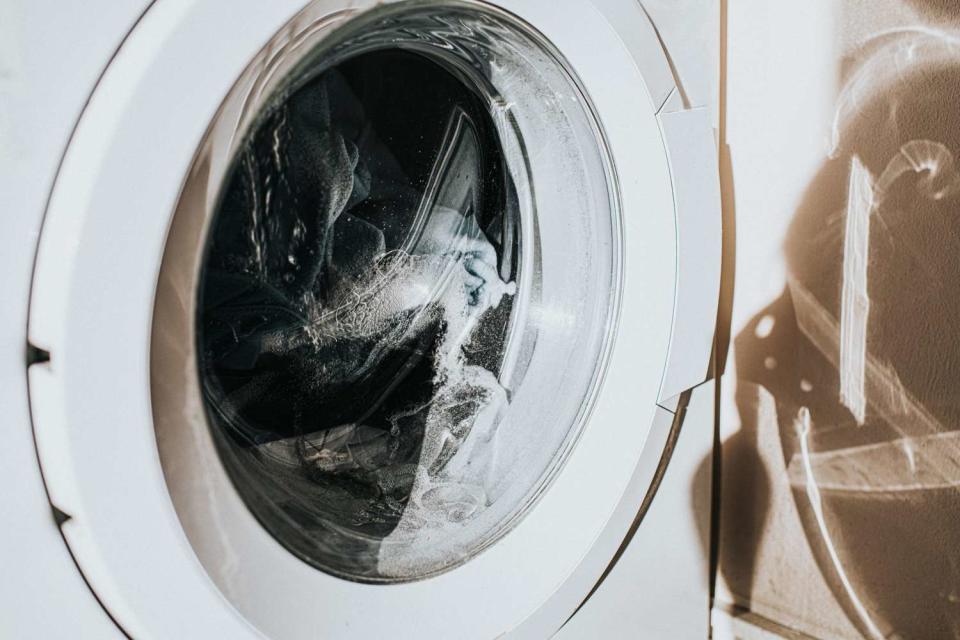How to Wash a Comforter (and Other Types of Blankets You Put on Your Bed)

Lilas Gh / GETTY IMAGES
TABLE OF CONTENTS
On This Page
Washing Frequency
Washing a Comforter
Washing Blankets
While we all know that we need to regularly wash our sheets, many of us forget that blankets and comforters also need to be cleaned. Just like sheets, blankets gradually acquire a buildup of anything from sweat to hair, so they'll need a routine refresh. If you aren't sure how to tackle the cleaning process, stay tuned. Ahead, we've shared tips from laundry experts to help you learn the right way to wash your comforters and other types of blankets.
How Often to Wash Your Comforter and Blankets
You should wash your comforter at least every few months to remove germs and debris, according to Rechelle Balanzat, a laundry and dry cleaning expert and the founder of Juliette, a premium laundry cleaning service based in New York City.
Cotton, Fleece, and Wool Blankets
Wash your other blankets once or twice a month for hygiene reasons, says Balanzat. Cotton blankets that you layer over sheets should be cleaned up to every week or every other week. "Your cotton blanket will accumulate less pet dander and house dust if you regularly shake it out and let it air out," says Balanzat.
Fleece blankets should be washed up to once or twice per month to preserve their quality. Balanzat recommends washing wool blankets every three months with a wool-safe, delicate detergent so they don't get damaged in the washing machine and dryer.
How to Wash and Dry Synthetic and Down Comforters
Before tossing your comforter in the washing machine, it's important to know which type you have: down or synthetic. Down comforters are stuffed with soft, natural undercoating from geese and ducks, whereas synthetic comforters are filled with man-made materials, says Maria Mooney, the brand director of Truly Free, a line of non-toxic laundry and household cleaning products.
"If you're deciding between purchasing a down- or synthetic-filled comforter, compare the differences to determine which one best fits your needs and wants," says Mooney. Down is typically warmer, lighter, and more breathable than synthetic (which is also known as down alternative). Each type requires specific washing and drying techniques, as explained below.
Synthetic Comforters
Before washing your synthetic comforter, read any instructions provided by the bedding brand.
Materials You'll Need
Laundry detergent
Wool dryer balls
Follow these expert-approved steps to wash and dry a synthetic comforter:
Set the washing machine temperature to either lukewarm to cold, as anything warmer could damage the comforter's fibers.
Use a small amount of laundry detergent. If you use an excessive amount of detergent, you could leave residue on the filling.
Wash the comforter on a delicate or gentle cycle with an extra rinse cycle if possible.
After the cycles are complete, assess the comforter for dampness. If it is still sopping wet, put it back in the washing machine for another spin cycle to help reduce drying time.
Continue by loading the comforter in the dryer with four to five wool dryer balls on a low heat setting (which can take up to a few hours). Even if the comforter seems dry, it's better to over-dry the fabric, as wet filling could cause mold.
Check the comforter every 30 minutes to redistribute the filling and break up clumps until it is completely dry.
Down Comforters
Again, make sure to read instructions before placing a down comforter in the washing machine and dryer to preserve its quality.
Materials You'll Need
Laundry detergent
Wool dryer balls
Follows these expert-approved steps to wash and dry a down comforter:
Only wash down comforters with a front-loading washer (the jerking action of the agitator in a top-load washer may cause damage by packing the down), according to Martha Stewart's Homekeeping Handbook. To handwash down, place it in a bathtub filled with lukewarm water and detergent.
Gently squeeze the soapy water through the down-filled article, then drain the wastewater, says Martha.
If you have a front-loading washer, choose a cold temperature setting (it's the safest wash temperature, since the fabric can shrink up to 8 percent in hot water).
Use the fastest spin speed to remove as much moisture as possible.
Add a laundry detergent of your choosing, and avoid using fabric softener, as this will coat the down and reduce its fluff.
Once the wash cycle is complete, run the dryer on air fluff or the lowest temperature possible since high heat can scorch down.
Dry with two to three wool dryer balls for about three to four hours and check every 30 minutes to break up clumps and ensure the down is not too warm.

Catherine Falls Commercial / Getty Images
How to Wash Blankets
Follow Balanzat's steps to wash other common types of blankets you have on your bed, including wool, cotton, and fleece.
Materials You'll Need
Gentle laundry detergent
Vinegar
Microfiber cloth
Wool Blankets
Before washing a wool blanket, the first step is to review the care label. "Most of the time, you only need to spot-clean it or clean it on a seasonal basis," says Balanzat. "Never use warm or hot water or a clothes dryer when washing wool [it could shrink and damage the fabric]."
Begin by either handwashing or adding a wool blanket to a washing machine with a short, gentle, cold-water cycle.
Wash the wool blanket with a wool-safe, delicate laundry detergent.
After washing, treat any stains on the blanket with cold water and a mild detergent or a vinegar solution (1/3 cup distilled white vinegar and 2/3 cup water).
Soak and blot the affected area with the desired cleaning solution and a clean microfiber cloth.
Either line dry or lay flat to dry the wool blanket.
Cotton Blankets
Make sure you check the care label on your cotton blankets, as many of these blankets are typically blended with other fabric types. Plus, 100 percent cotton blankets can shrink if you aren't careful. "Your cotton blanket's label may say that it is okay to machine wash it in cold or warm water and tumble dry it on low heat, which is fine, but you can shorten the drying time to increase longevity," says Balanzat. "If there are any noticeable stains, carefully handwash the affected area in warm water with diluted detergent before putting the blanket in your washing machine on cold."
Fleece Blankets
Always wash fleece blankets separately in cold water on a gentle cycle whenever possible to avoid pilling or matting. "Use only a small amount of detergent—more soap won't necessarily make your blanket cleaner," says Balanzat. "In fact, too much detergent can adhere to the fleece fibers and reduce the softness of your blanket."
Another pro tip: Avoid using bleach, as this could deteriorate the blanket's fibers or change the color. Since polyester fleece is naturally stain-resistant, Balanzat says that washing your fleece blanket in cold water with detergent should be able to get rid of any stains. However, you can pre-treat stubborn stains with a drop of dishwashing liquid, like Dawn, and let it sit for about 10 minutes before washing.

